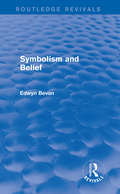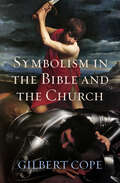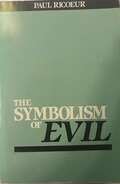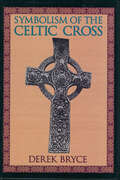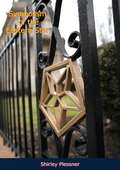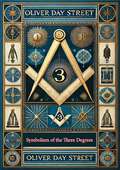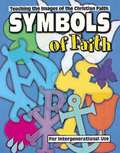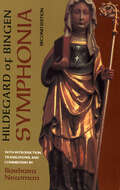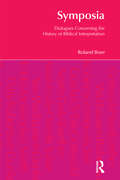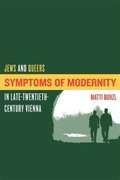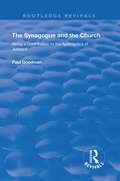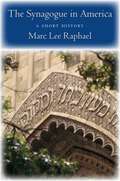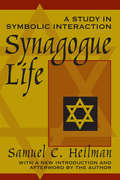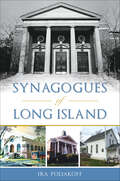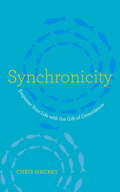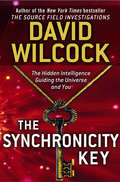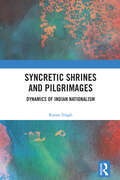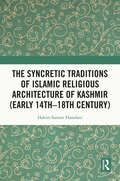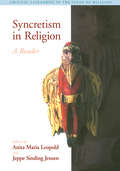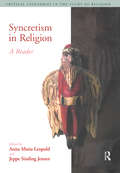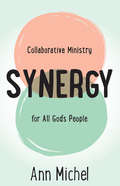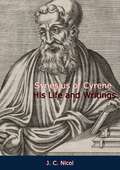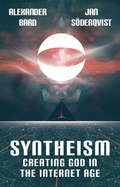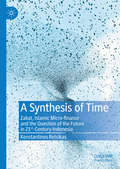- Table View
- List View
Symbolism and Belief: Gifford Lectures (Routledge Revivals)
by Edwyn BevanFirst published in 1938, this title presents the greater part of the 1933 Gifford Lectures in natural theology, given by Edwyn Bevan. The questions raised regarding the element of symbolism in religious conceptions takes the reader to the very heart of the religious problem, and addresses some of the most fundamental questions posed by theology and comparative religion: the nature of ‘Spirit’; the spiritual efficacy of sacred histories and the images they utilise, in particular those found in the Bible; the ambiguous role of language, not only in relation to God but also to the world around us; and the uncertainties pertaining to ‘rationalism’ and ‘mysticism’. Symbolism and Belief offers the student of theology, philosophy, scriptural exegesis and anthropology a wide-ranging resource for the study of religious discourse.
Symbolism in the Bible and Church
by Gilbert CopeA theologian explores the rich imagery and symbolism of the Bible and the Church, offering a new path for spiritual inspiration in the modern era. Does the imagery of the Bible correspond to our present understanding of the human psyche and its environment? Do the doctrinal and ritual patterns of the Church offer effective structure and spiritual orientation for modern life? In Symbolism in the Bible and the Church, theologian Gilbert Cope evaluates these pillars of traditional Hebrew-Christian &“mythology&” in light of our post-Darwinian, post-Freudian, and post-Einsteinian age. In this lucid and wide-ranging study, Cope argues that the imagery and symbolism of the Bible and the Church are more vital than ever. While the scientific method has opened a door to knowledge, it has also opened a door to ignorance. The more we discover, the more we realize how little we know.
The Symbolism of Evil
by Paul Ricoeur"According to Ricoeur, the most primal and spontaneous symbols of evil are defilement, sin and guilt ... Ricoeur moves from the elementary symbols of evil into the rich world of myths ... and he ends by suggesting that the clue to the relation between philosophy to mythology is to be found in the aphorism 'The symbol gives rise to the thought' ... Ricoeur's method and argument are too intricate and rich to assess in so short a review. Suffice it to say that this is the most massive accomplisment of any philosopher within the ambience of Christian faith since the appearance of Gabriel Marcel" – Sam Keen, The Christian Century
Symbolism of the Celtic Cross
by Derek BryceA guide to the basic symbolism of the Celtic Cross, featuring rare illustrations.Did you know that the basic symbolism of the cross is that of the world axis, or the link between Heaven and Earth? Or that the main feature of the ornamented Celtic Cross, the wheel cross, is not derived from the crucifixion, but from a more ancient symbol the Chi-Rho monogram, which is the name of Christ in the Greek alphabet?In Symbolism of the Celtic Cross, Derek Bryce traces the pagan-Christian link of the essential symbolism of the axis mundi from standing stones and market crosses (at crossroads and not always “crosses” in form) to the inscribed slabs and freestanding crosses of the Celtic-Christian era. He includes rare illustrations of ornamental Celtic Crosses from such places as Brittany, Wales, Scotland, the Isle of Man, Cumbria, Ireland, and Cornwall. Bryce explores esoteric aspects of the symbolism, alchemy, and the wisdom of Hermes.
Symbolism of the Eastern Star
by Shirley PlessnerThis book by Shirley Plessner, which was first published in 1956, was compiled in response to numerous requests for informative material about the symbols, terms, and stories of the Order of Eastern Star.The Order of the Eastern Star is a Masonic appendant body open to both men and women. It was established in 1850 by lawyer and educator Rob Morris, a noted Freemason, but was only adopted and approved as an appendant body of the Masonic Fraternity in 1873. The order is based on teachings from the Bible, but is open to people of all religious beliefs. It has approximately 10,000 chapters in twenty countries and approximately 500,000 members under its General Grand Chapter.“This book contains a complete discussion of the whole biblical account from which the teachings of the Order of Eastern Star are derived. Like all such interpretations, no effort is made to establish it as the one and only interpretation. Each discussion is a collection of ideas which are designed to assist the reader in forming his own conclusions concerning each selection. This book also contains the Bible passages from which our symbols, emblems, terms and stories have been taken. All of the information in this book has been alphabetically arranged to make this information readily accessible.“Use this book to find the answers to your questions about the symbols, emblems, terms, and legends associated with the work of our Order.”
Symbolism of the Three Degrees
by Oliver Day StreetSymbolism of the Three Degrees by Oliver Day Street is a masterful exploration of the rich and intricate symbolism embedded within the first three degrees of Freemasonry. This classic work offers a detailed analysis of the symbolic meanings and teachings that are central to Masonic rituals, providing both new initiates and seasoned Masons with a deeper understanding of the profound lessons contained within these degrees.Oliver Day Street, a respected Masonic scholar, delves into the origins, development, and significance of the symbols used in the Entered Apprentice, Fellow Craft, and Master Mason degrees. He meticulously interprets the allegories, rituals, and symbols that have been passed down through generations of Masons, revealing their spiritual and philosophical implications.Symbolism of the Three Degrees explores how these symbols serve as tools for personal growth, moral instruction, and the pursuit of truth. Street connects Masonic symbolism to broader esoteric and philosophical traditions, illustrating how these ancient symbols reflect universal principles of human experience and spiritual enlightenment.Street’s work is particularly valuable for its clarity and accessibility, making complex Masonic concepts understandable for readers of all levels. His thorough analysis helps Masons appreciate the depth and wisdom of the rituals they participate in, encouraging them to reflect on the ethical and spiritual lessons they embody.This book is an essential resource for anyone interested in Freemasonry, whether they are members of the fraternity or simply curious about its symbolism and teachings. Symbolism of the Three Degrees offers a comprehensive and insightful guide to the symbols that form the foundation of Masonic thought and practice.Oliver Day Street’s scholarly yet approachable style makes this work a timeless reference for those seeking to understand the deeper meanings of Masonic rituals. This book continues to inspire and enlighten readers, providing a valuable contribution to the study of Freemasonry and its enduring legacy.
Symbols of Faith: Teaching Images of the Christian Faith
by Marcia StonerHelp persons of all ages understand the symbols of the faith! This resource includes over 60 Christian symbols with acitivities designed to teach the background of each symbol. Reproducible patterns included for most symbols.
Symphonia: A Critical Edition of the "Symphonia Armonie Celestium Revelationum" (Symphony of the Harmony of Celestial Revelations)
by Hildegard of BingenFor this revised edition of Hildegard's liturgical song cycle, Barbara Newman has redone her prose translations of the songs, updated the bibliography and discography, and made other minor changes. Also included is an essay by Marianne Richert Pfau which delineates the connection between music and text in the Symphonia.Famous throughout Europe during her lifetime, Hildegard of Bingen (1098-1179) was a composer and a poet, a writer on theological, scientific, and medical subjects, an abbess, and a visionary prophet. One of the very few female composers of the Middle Ages whose work has survived, Hildegard was neglected for centuries until her liturgical song cycle was rediscovered. Songs from it are now being performed regularly by early music groups, and more than twenty compact discs have been recorded.
Symposia: Dialogues Concerning the History of Biblical Interpretation (BibleWorld)
by Roland Boer'Symposia' illuminates the central issues and concerns of biblical studies by presenting a series of stories. The model for the stories is the ancient Greek idea of the symposium, a 'sitting down together for the purpose of drinking'. In Plato's writings, the symposium becomes a genre of writing with Socrates at its centre, a character who perpetually questions in order to develop the pursuit of knowledge. Some of the most influential figures in the history of biblical studies - Julius Wellhausen, Hermann Gunkel, Martin Noth, Brevard Childs, Norman Gottwald, Phyllis Trible, and the Bible and Culture Collective - become the central characters in these stories. Each aims to voice their central arguments, to highlight and confront the key challenges they see and, of course, to dispute the positions of others.
Symptoms of Modernity: Jews and Queers in Late Twentieth-century Vienna
by Matti BunzlThis book is an ethnography of Central European modernity in the form of a comparative study of Jews and queers in late twentieth-century Vienna.
The Synagogue and the Church: BEING A CONTRIBUTION TO THE APOLOGETICS OF JUDAISM (Routledge Revivals)
by Paul GoodmanPublished in 1908, this book details the development and establishment of Judaism and Jewish culture in contrast to the spread and presence of the Christian church and community. Focusing on the spiritual importance of Jewish scripture and its prominence in other Abrahamic religions, Goodman presents a discussion on spiritual and ethical perspectives in Judaism in comparison to Christianity.
The Synagogue in America: A Short History
by Marc Lee Raphael&“An insightful, scholarly, and comprehensive overview of the evolution and changing role of the American synagogue" (Choice). In 1789, when George Washington was elected the first president of the United States, laymen from all six of the new nation&’s Jewish congregations sent him congratulatory letters. He replied to all six—thus recognizing these religious institutions as part of the new nation. By this time, the synagogue had become the focal point of American Jewish life, a dominance that was not challenged until the twentieth century, when institutions such as Jewish community centers or Jewish philanthropic organizations claimed to be the hearts of their Jewish communities. Concise yet comprehensive, The Synagogue in America is the first history of this all-important institution, illuminating its changing role within the American Jewish community over the course of three centuries. From Atlanta and Des Moines to Los Angeles and New Orleans, Marc Lee Raphael examines Orthodox, Reform, Conservative, and Reconstructionist synagogues. He traces the emergence of the American synagogue from the colonial period to its modern proliferation and diversification. Encompassing architecture, forms of worship, rabbinic life, fundraising, creative liturgies, and feminism, The Synagogue in America is the go-to history for understanding the synagogue&’s significance in American Jewish life.
Synagogue Life: A Study in Symbolic Interaction
by Samuel C. HeilmanVia a participant-observer approach, Synagogue Life analyzes the three essential dimensions of synagogue life: the houses of prayer, study, and assembly. In each Heilman documents the rich detail of the synagogue experience while articulating the social and cultural drama inherent in them. He illustrates how people come to the synagogue not only for spiritual purposes but also to find out where and how they fit into life in the neighborhood in which they share.In his new introduction, Heilman discusses what led him to write this book and the process of personal transformation through which he, as an Orthodox Jew, had to go in order to turn a disciplined eye on the world from which he came. Rather than using the stranger-as-native approach of classic anthropology, he had instead to begin as a native who discoverd how to look at a once-taken-for-granted synagogue life like a stranger. In the afterword, arguing for the efficacy of this approach, Heilman offers guidance on how natives can use their special familiarity and still be trained to distance themselves from their own group, making use of the disciplines of sociology and anthropology. Synagogue Life offers a fascinating portrait that has something to say to social scientists as well as all those curious about what happens in the main arena of Orthodox Jewish community life.
Synagogues of Long Island (Landmarks)
by Ira PoliakoffLong Island has one of the most vibrant and largest Jewish communities in the nation.After World War II, hundreds of thousands of Jewish soldiers returned from war looking for a life in the suburbs and synagogues to join, but the demand exceeded the supply. In 1946, Rabbi Elias Solomon called a meeting of Conservative rabbis from Manhattan to map out a plan to build a synagogue at ever South Shore Long Island Railroad stop, from Valley Stream to Patchogue. Central Synagogue of Nassau County and Beth El in Great Neck both grew to more than 1000 families as Reform Judaism took hold, and the growth of the Chabad movement in recent decades as spurred an increase of Orthodox Judaism. Author Ira Poliakoff catalogues the history of synagogues and congregations that have shaped Long Island's past and present.
Synchronicity
by Chris MackeySynchronicity: the uncanny and fortuitous timing of events that seems to go beyond pure chance. Synchronicity can act as a guide along our life path, helping us through challenging times and nudging us toward self-fulfillment.Psychologist Chris Mackey offers astounding case studies, alongside a lucid explanation of the brain science underlying synchronicity and many practical suggestions for working with it, from journaling and symbol analysis to dream interpretation and ideas for accessing flow. He is convinced that synchronicity has a crucial role to play in helping us "go within" and tap intoour intuitive and spiritual selves.This book is also a passionate call for a new, more optimistic "positive psychiatry" that embraces our transcendent experiences. A 21st-century take on Jung's legacy, this exciting new approach to synchronicity will appeal to anyone interested in the opportunities for personal development offered by altered states of consciousness."A profound introduction to deep concepts of mind, meaning and the challenges of creating a life well lived for everyone."--Ernest Rossi, Ph.D., author of The Psychobiology of Gene Expression and Creating ConsciousnessFrom the Hardcover edition.
The Synchronicity Key: The Hidden Intelligence Guiding the Universe and You
by David WilcockIn The Hidden Science of Lost Civilisations David Wilcock exposed some of the greatest scientific secrets of our time to unlock the mysteries man-kind have always struggled to answer: who are we, how did we get here and where are we going? In The Synchronicity Key David Wilcock goes beyond this new understanding to investigate how our universe works. Using history and astrology, as well as new scientific research, Wilcock demonstrates there is a hidden architecture within time which guides individuals and nations through a system of enlightenment.
Syncretic Shrines and Pilgrimages: Dynamics of Indian Nationalism
by Karan SinghThis book looks at various syncretic traditions in India, such as Bhakti, Nath Yogi, Sufi, Imam Shahi, Ismailis, Khojas and others, and presents an elaborate picture of a redefined cultural space through them. It also investigates different syncretisms - Hindu-Muslim, Hindu-Muslim-Christian and Aboriginal-Ethnic - to understand diverse aspects of hybridity within the Indian nation space. It discusses how Indian nationalism was composed of different opinions from its inception, reflecting its rich diversity and pluralistic traditions. The book traces the emergence of multiple contours of Indian nationalism through the historical trajectory of religious diversity, lingering effects of colonialism, and experimentation with secularism. This volume caters to scholars and students interested in cultural studies, religion studies, pilgrimage studies, history, social anthropology, historical sociology, historical geography, religion and art history. It will also be of interest to political theorists and general readers.
The Syncretic Traditions of Islamic Religious Architecture of Kashmir (Early 14th –18th Century)
by Hakim Sameer HamdaniThis book traces the historical identity of Kashmir within the context of Islamic religious architecture between early fourteenth and mid-eighteenth century. It presents a framework of syncretism within which the understanding of this architectural tradition acquires new dimensions and possibilities in the region. In a first, the volume provides a detailed overview of the origin and development of Islamic sacred architecture while contextualizing it within the history of Islam in Kashmir. Covering the entirety of Muslim rule in the region, the book throws light on Islamic religious architecture introduced with the establishment of the Muslim Sultanate in the early fourteenth century, and focuses on both monumental and vernacular architecture. It examines the establishment of new styles in architecture, including ideas, materials and crafts introduced by non-Kashmiri missionaries in the late-fourteenth to fifteenth century. Further, it discusses how the Mughals viewed Kashmir and embellished the land with their architectural undertakings, coupled with encounters between Kashmir’s native culture, with its identity and influences introduced by Sufis arriving from the medieval Persianate world. The book also highlights the transition of the traditional architecture to a pan-Islamic image in the post-Independence period. With its rich illustrations, photographs and drawings, this book will interest students, researchers, and professionals in architecture studies, cultural and heritage studies, visual and art history, religion, Islamic studies and South Asian studies. It will also be useful to professional architecture institutes, public libraries, museums, cultural and heritage bodies as well as the general reader interested in the architectural and cultural history of South Asia.
Syncretism in Religion: A Reader (Critical Categories in the Study of Religion)
by Anita M. Leopold Jeppe S. JensenLong a fascinating but problematic category of religious studies, "syncretism" is an elastic term that describes a wide range of practices characterized by the mixing or overlap of traditions. Syncretism in Religion offers the student a broad selection of essays, both classical contributions to the study of syncretism and new essays commissioned especially for this volume. Some important selections appear here in English for the first time. Also included is a list of references for further reading.
Syncretism in Religion: A Reader (Critical Categories in the Study of Religion)
by Anita Maria Leopold Jeppe Sinding JensenSyncretism - the fusion of different beliefs into one religious system - has long been controversial in scholarship. It is widely held that religion, culture and ethnicity are pure entities that may become mixed in encounter and lead to impure, hybrid forms. 'Syncretism in Religion' presents a selection of essays committed to solving the problems of syncretism. The essays reflect the full breadth of religious traditions that could be called syncretistic. An overview of the historical background of syncretism is given, alongside classical readings from the history of religion, definitions of syncretism in relation to theories of power, and an assessment of the future of the subject. This volume brings together the work of authors who have made significant contributions in the field, some appearing for the first time in English. It will be of interest to any student or scholar of religion, philosophy or anthropology concerned with the dynamics of cultural contact and change.
Synergy: A Leadership Guide for Church Staff and Volunteers
by Ann A. MichelThe people are the church—not just the pastor. Yet, in many congregations there is a heavy imbalance in the ownership of ministry. Clergy and paid staff are seen as God’s agents in the world, and congregants as occasional participants. Sometimes, clergy and other leaders perpetuate this imbalance. Ann Michel presents a more inclusive, collaborative understanding of ministry, which affirms the gifts and calling of both clergy and lay servants. She uses the concept of “synergy” as a theological framework undergirding this approach. Michel lays out an inclusive and collaborative paradigm of ministry affirming the work of both lay and clergy servants. Synergy also provides practical advice on the day-to-day skills of synergistic or collaborative ministry – how to engage others in ministry, how to build teams, how to manage meetings, how to develop others as leaders, etc. The book helps church workers, paid and unpaid, understand how their ministry relates to the mission of God and the ministry of the church, and provides practical guidance on the interpersonal ministry skills essential to any expression of collaborative ministry. "Synergy is both a practical and deeply spiritual resource that helps provide a more collaborative way of thinking about ministry shared between clergy and laity. Ann has captured the challenges that can present themselves as laity serve in ministry not only from her research but also from her personal experience as a lay person and respected Seminary theologian, and she offers practical ways to equip laity to fully live in this call of lay servants and lay staff members. As a lay person who has served on a church staff for more than 23 years, understanding this synergistic energy articulated so well in Ann’s writing has reignited my passion and affirmed my call." - Debi Williams Nixon, Managing Executive Director, The United Methodist Church of the Resurrection
Synesius of Cyrene His Life and Writings: His Life And Writings
by J. C. NicolSynesius was a Greek Bishop of Ptolemais and Neo-Platonic philosopher in the Cyrenaica. His writings are perhaps most notable for the tension they reveal between his Christian and Platonist beliefs. "Synesius pursued his higher studies at Alexandria, where he became a devoted disciple of the famous Hypatia, to whom several of his letters are addressed and for whom he entertained a life-long devotion. After serving sometime in the army he settled in his native land, studying philosophy, mathematics, astronomy, everything; farming, hunting, having many a brush with hordes of pilfering Libyans; and every now and then upholding the cause of someone who had undeservedly fallen into difficulties". This kind of life, in every way suited to his tastes and disposition, was interrupted by a mission to Constantinople, the object of which was to present a gold crown to the new emperor, Arcadius, and obtain alleviation of the burden of taxation. Nearly three years he waited for an audience. The all-powerful Eutropius who sold the provinces to the highest bidder was not the man to allow the emperor to be troubled with complaints. Finally, Synesius obtained an audience and delivered his famous oration "On Kingship". He left Constantinople in 400. According to some authorities before, and according to others after, the mission to Constantinople, Synesius visited Athens. He had described the visit in two letters [54 and 135] to his brother, Euoptius. His reason for undertaking the voyage was, he jestingly said, that "a number of people, priests and private persons, had had revelations in dreams that, unless he did so, some great evil would befall him. Then he would escape the present evils and would no longer have to revere people who had been to Athens and regarded themselves as demigods, and those who had not as demidonkeys or mules." Athens was a disappointment. Like a beast that had been sacrificed, only the hide remained. —Catholic Encyclopedia
Synopsis of the Four Gospels
by Kurt AlandThe English portion of Synopsis Quattuor Evangeliorum. Completely revised on the basis of the Greek Text of Nestle-Aland 26th Edition and Greek New Testament 3rd Edition. The Text is the Second Edition of the Revised Standard Version.
Syntheism - Creating God in the Internet Age
by Alexander Bard Jan SöderqvistA NEW REVOLUTIONARY VIEW OF THE FUTURE FROM THE AUTHORS OF THE INTERNATIONAL BESTSELLER THE FUTURICA TRILOGY This book has the audacity to describe individualism as a religion and to depict reality as being primarily virtual rather than physical. Though the authors rattle the reader's perception of both the self and the world, their overriding purpose is to induce passive recipients of the future to instead become active participants. Through engaging observations, lucid interpretations and an accessible style, Bard & Söderqvist serve up a challenging analysis of our present and offer inspiring insight into the dramatic twists and turns of our tomorrow. "Bard himself is as fascinating as is his trilogy... The books are eminently readable." - Publishing Perspectives Alexander Bard and Jan Söderqvist are Swedish philosophers and authors of the internationally successful Futurica Trilogy. They lecture the world over about the current global internet revolution. Bard & Söderqvist are regarded as pioneers in the literary genre futurica, where philosophy, social theory and futurology merge. After joining forces in the late 1990's, Bard & Söderqvist argued that the interactive revolution is the most profound and radical of all technological revolutions in history, that it completely transforms society, politics, the economy and the culture, social power structures, the collective world view and the whole concept of being human. They demonstrated the effects of digital dynamics on various levels of a globalized world. They not only made controversial predictions in the early years of the new millennium (and cleverly foresaw both the dot.com crash and September 11), they have since then been proven right in virtually every aspect and even in the most minute of detals. Not only did Bard & Söderqvist foresee revolutionary innovations such as Google, Facebook, Al-Qaida and Wikileaks; they also went deeper and looked into the very power struggle of the on-going revolution itself. Bard & Söderqvist are now back with a new metaphysics for the digital age.
A Synthesis of Time: Zakat, Islamic Micro-finance and the Question of the Future in 21st-Century Indonesia
by Konstantinos RetsikasThis book is an anthropological investigation into the different forms the economy assumes, and the different purposes it serves, when conceived from the perspective of Islamic micro-finance as a field of everyday practice. It is based on long-term ethnographic research in Java, Indonesia, with Islamic foundations active in managing zakat and other charitable funds, for purposes of poverty alleviation. The book explores the social foundations of contemporary Islamic practices that strive to encompass the economic within an expanded domain of divine worship and elucidates the effects such encompassment has on time, its fissure and synthesis. In order to elaborate on the question of time, the book looks beyond anthropology and Islamic studies, engaging attentively, critically and productively with the post-structuralist work of G. Deleuze, M. Foucault and J. Derrida, three of the most important figures of the temporal turn in contemporary philosophy.
